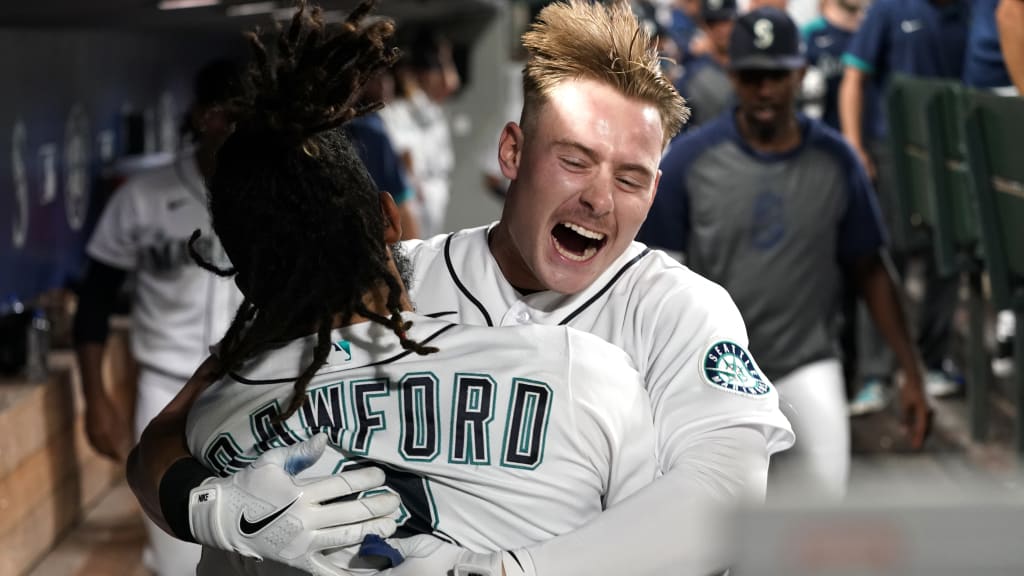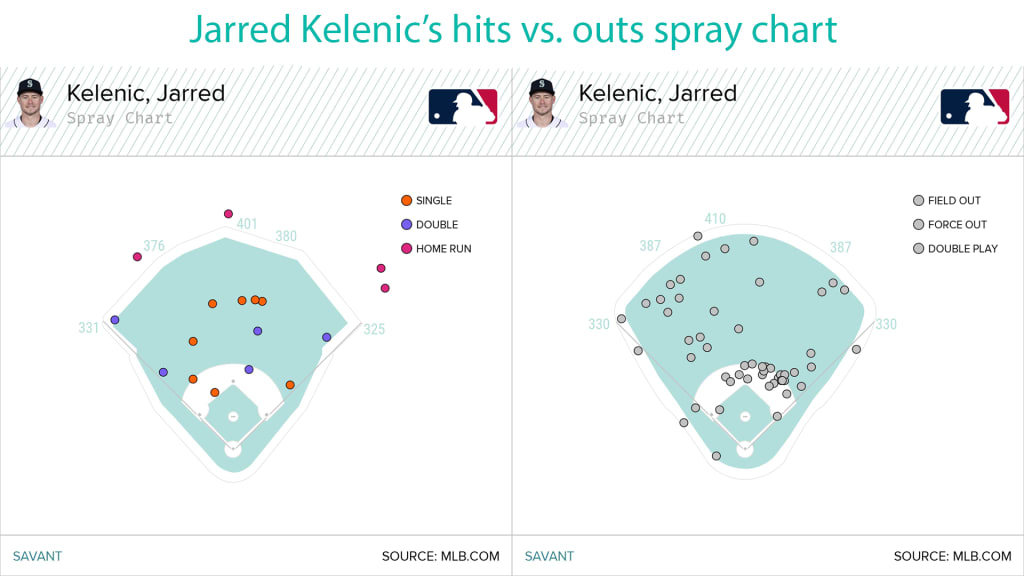
ARLINGTON -- Jarred Kelenic snapped a fairly significant streak in Sunday’s loss to the Blue Jays, and if you weren’t looking closely, it would’ve been extremely easy to miss.
Seattle’s rookie center fielder struck out in his third at-bat in the sixth inning, a forgettable sequence in a forgettable 8-3 loss. But for Kelenic, who struggled so mightily in his first big league stint, it was notable because it was the first time he fanned in a full week. And his most recent K before that was far from forgettable because it ended with his first career ejection for arguing with the home-plate umpire.
Spanning that seven-day stretch underscores the growth Kelenic has had with his approach, but also, the growth the Mariners would still like to see with his temper. Anyways, let’s dive into the former and illustrate why MLB Pipeline’s recently-graduated No. 4 overall prospect has steered back on track this month:
The new stance
Kelenic’s mid-game adjustment to a more-upright, less-compact stance on July 27 against the Astros was well-chronicled, but it truly appears to have made a huge difference. He did so to better decipher breaking balls out of pitchers’ hands, and his results have skyrocketed.
Kelenic vs. breaking balls
Old stance (May 13-July 26): .061 BA | .082 SLG | 37.7% whiff rate
New stance (since July 27): .286 BA | .429 SLG | 28.9% whiff rate
“I think I'm seeing the ball really well,” Kelenic said. “I talked about earlier, that being a little bit more upright has kind of helped me see pitches at the top of the strike zone a little bit better, and not chase the balls down, just changing my eye level. And I think that it's really opened it up where I'm kind of targeting one spot, and that's what I'm focusing on.”
One of Kelenic’s most glaring struggles early was his inability to make contact on secondary pitches, and while there is still plenty of room to grow here, now that he’s begun to improve, it’s forced pitchers to mix up their arsenal against him.
He’s better exploiting a strength
Kelenic has been crushing high-90s velocity since he was a teenager, and making contact against heaters was never an issue, even when he went hitless in his final 42 plate appearances before his Minor League demotion on June 7. In his first stint, he swung and missed at just 10 fastballs -- yes, 10 total -- yet those batted balls seemingly always found a glove.
Such was the case even after he made the stance change. But Kelenic stayed with his opposite-field-driven approach, knowing that doing so would keep shifted defenses honest and that he’d have stronger shots to turn on his jets for extra bases on balls in the gaps.

Sure enough, Kelenic broke through with an authoritative, 384-foot, oppo homer in Seattle’s late-innings offensive onslaught on Saturday against Toronto. He also drilled a double off Robbie Ray directly down the left-field line earlier that night.
“I'm really trying to just stay the other way. I'm not trying to pull the baseball at all and just letting that become a reaction,” Kelenic said. “And I was so fired up with myself in the first [at-bat] there when I hit that ball that short-hopped the wall, especially off a lefty, letting the ball get deep there on like a 95 mph fastball -- because when I stepped into the box, that's exactly what I pictured to do with that pitch. And to execute that, it's awesome.”
Kelenic’s strongest power is pull side, but he’s not selling out for it the way he perhaps was early, which leads us to…
He’s far more patient -- and mature
Sure, Kelenic wants to be the hero on any given night, but he’s OK with dodging the dramatic if it gets the Mariners where they want to go, like his four-pitch walk-off walk against three-time All-Star Brad Hand did on Friday. The 22-year-old said he likely would’ve been swinging for the fences had he not been humbled over his first month in The Show.
Beyond his patience, that moment also accentuated the quality of Kelenic’s at-bats these days -- and while there are more factors than just his new stance, that adjustment has been the most distinct turning point.
“The approach is there -- he's still looking to swing the bat,” Mariners manager Scott Servais said. “But if the pitch isn't there, he's got enough confidence to take it and move on. … I think early on, Jarred put a lot of pressure on himself trying to do a little bit too much and chasing hits and chasing trying to be the hero and carry a ballclub. Now, he's just focused on doing whatever he can to help us win a ballgame, and it's a much easier to come to the park that way and not feel like you have to carry the weight of the world in your shoulder.”
Kelenic’s plate discipline, before/after stance change
Chase rate: 30.2% | 25.2%
Contact rate: 73.8% | 79.7%
BB rate: 9.2% | 12.0%
K rate: 33.6% | 17.3%
OPS: .360 | .826
wRC+ (league average is 100): 7 | 128

OK, but what’s next?
Put simply, the need for consistency. Tuesday’s series opener at Texas marked three weeks since Kelenic installed his stance, and overall, he’s hit .246/.333/.492 in 75 plate appearances with the new look -- a decent yet still marginal sample size.
Certainly, hitting lower in the lineup has helped ease some of the burden after batting leadoff in each of his first 17 starts. But beyond the mechanical changes, there’s been a pretty notable mental one, too.
“The more and more I'm around this environment, you kind of have the mindset of, ‘If it doesn't happen, if I don't capitalize here, I'll do it the next at-bat. If I don't capitalize there, I'll do it the next one. If I don't capitalize today, I'll capitalize tomorrow,’” Kelenic said.
“And that's the fortunate thing about playing every day, is you get so many opportunities that I think that's something that I struggled with early on when I first came up. Every at-bat to me, it was kind of like life or death situation, and now, it's not. Like, even in the situation there, if I struck out or grounded out, whatever, like absolutely, I'd be frustrated. But I'm getting over stuff a lot faster.”


